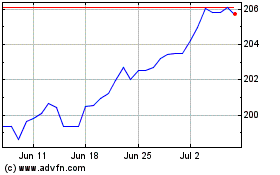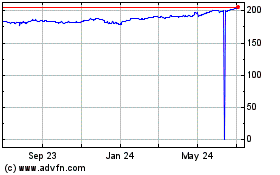Pound Falls After Weak U.K. Industrial Production, Trade Data
July 07 2017 - 1:31AM
RTTF2
The pound drifted lower against its major rivals in early
European deals on Friday, as U.K. industrial production dropped
unexpectedly and trade deficit widened in May, casting doubts over
the nation's economic recovery.
Data from the Office for National Statistics showed that UK
industrial production fell unexpectedly in May.
Industrial output fell 0.1 percent month-on-month in May,
confounding expectations for an increase of 0.4 percent and
reversed a 0.2 percent rise registered in April.
At the same time, manufacturing output dropped 0.2 percent,
offsetting a 0.2 percent rise in April. Output was forecast to gain
0.5 percent.
Separate data from the same agency showed that the U.K. total
trade deficit jumped by GBP 1 billion to GBP 3.1 billion in
May.
The UK visible trade deficit widened to GBP 11.86 billion from a
revised GBP 10.60 billion in April. Economists had expected a
shortfall of GBP 10.85 billion.
Data from the mortgage lender Halifax and IHS Markit showed that
UK house prices declined for the first time in five months in
June.
House prices fell unexpectedly by 1 percent on a monthly basis,
reversing a 0.3 percent rise in May. This was the first decline
since January. Prices were forecast to grow 0.2 percent.
Risk sentiment dampened on falling oil prices as well as rising
global yields after hawkish ECB minutes. Traders now await U.S.
jobs data later in day, after weak private payrolls data suggested
a possible slowdown in labor market activity.
The pound showed mixed performance in the Asian session. While
the pound held steady against the franc and the euro, it fell
against the greenback. Against the yen, it rose.
The pound declined to 0.8839 against the euro, its weakest since
June 28. This marks a 0.4 percent decline from Thursday's closing
value of 0.8807. Continuation of the pound's downtrend may see it
challenging support around the 0.90 region.
Data from Destatis showed that German industrial production grew
at the fastest pace in four months in May.
Industrial production grew 1.2 percent month-on-month in May,
faster than the 0.4 percent increase seen in April and exceeded
economists' forecast of 0.2 percent.
The pound dropped to a 2-day low of 1.2913 against the
greenback, compared to 1.2970 hit late New York Thursday. If the
pound-greenback pair extends decline, 1.28 is likely seen as its
next support level.
The pound that closed yesterday's trading at 1.2457 against the
franc dropped to a weekly low of 1.2431. The pound is poised to
target support around the 1.22 level.
Pulling away from an early nearly 2-month high of 147.61 against
the yen, the pound eased to 146.84. The next possible support for
the pound-yen pair is seen around the 143.00 mark.
Preliminary data from the Cabinet Office showed that Japan's
leading index strengthened in May, while coincident index fell from
April.
The leading index that measures the future economic activity,
rose to 104.7 in May from 104.2 in April. The score was forecast to
rise to 104.6.
Looking ahead, U.S. jobs data for June is due in the New York
session.
Sterling vs Yen (FX:GBPJPY)
Forex Chart
From Mar 2024 to Apr 2024

Sterling vs Yen (FX:GBPJPY)
Forex Chart
From Apr 2023 to Apr 2024
